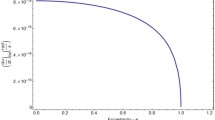Abstract
In the framework of the MOdified Newtonian Dynamics (MOND), the internal dynamics of a gravitating system s embedded in a larger one S is affected by the external background field E of S even if it is constant and uniform, thus implying a violation of the Strong Equivalence Principle: it is the so-called External Field Effect (EFE). In the case of the solar system, E would be A cen≈10−10 m s−2 because of its motion through the Milky Way: it is orders of magnitude smaller than the main Newtonian monopole terms for the planets. We address here the following questions in a purely phenomenological manner: are the Sun’s planets affected by an EFE as large as 10−10 m s−2? Can it be assumed that its effect is negligible for them because of its relatively small size? Does E induce vanishing net orbital effects because of its constancy over typical solar system’s planetary orbital periods? It turns out that a constant and uniform acceleration, treated perturbatively, does induce non-vanishing long-period orbital effects on the longitude of the pericenter ϖ of a test particle. In the case of the inner planets of the solar system and with E≈10−10 m s−2, they are 4–6 orders of magnitude larger than the present-day upper bounds on the non-standard perihelion precessions \(\Delta\dot{\varpi}\) recently obtained with by E.V. Pitjeva with the EPM ephemerides in the Solar System Barycentric frame. The upper limits on the components of E are E x ≤1×10−15 m s−2, E y ≤2×10−16 m s−2, E z ≤3×10−14 m s−2. This result is in agreement with the violation of the Strong Equivalence Principle by MOND. Our analysis also holds for any other exotic modification of the current laws of gravity yielding a constant and uniform extra-acceleration. If and when other corrections \(\Delta\dot{\varpi}\) to the usual perihelion precessions will be independently estimated with different ephemerides it will be possible to repeat such a test.
Similar content being viewed by others
References
Angus, G., McGaugh, S.: Mon. Not. R. Astron. Soc. 383, 417 (2008)
Begeman, K., Broeils, A., Sanders, R.: Mon. Not. R. Astron. Soc. 249, 523 (1991)
Bekenstein, J., Milgrom, M.: Astrophys. J. 286, 7 (1984)
Bertotti, B., Farinella, P., Vokrouhlický, D.: Physics of the Solar System. Kluwer, Dordrecht (2003), 313 p.
Famaey, B., Bruneton, J.-P., Zhao, H.-S.: Mon. Not. R. Astron. Soc. 377, L79 (2007a)
Milgrom, M.: Astrophys. J. 270, 365 (1983a)
Milgrom, M.: Astrophys. J. 270, 371 (1983b)
Milgrom, M.: Astrophys. J. 270, 384 (1983c)
Milgrom, M.: Astrophys. J. 302, 617 (1986)
Montenbruck, O., Gill, E.: Satellite Orbits. Springer, Berlin (2000), p. 27
Pitjeva, E.V.: Astron. Lett. 31, 340 (2005)
Pitjeva, E.V.: Use of optical and radio astrometric observations of planets, satellites and spacecraft for ephemeris astronomy. In: Jin, W.J., Platais, I., Perryman, M.A.C. (eds.) A Giant Step: from Milli- to Micro-arcsecond Astrometry. Proceedings of IAU Symposium, vol. 248, p. 20, 2007. Cambridge University Press, Cambridge (2008)
Sanders, R., McGaugh, S.: Annu. Rev. Astron. Astrophys. 40, 263 (2002)
Wu, X., Famaey, B., Gentile, G., Perets, H., Zhao, H.: Mon. Not. R. Astron. Soc. 386, 2199 (2008)
Author information
Authors and Affiliations
Corresponding author
Rights and permissions
About this article
Cite this article
Iorio, L. On the MOND external field effect in the solar system. Astrophys Space Sci 323, 215–219 (2009). https://doi.org/10.1007/s10509-009-0061-3
Received:
Accepted:
Published:
Issue Date:
DOI: https://doi.org/10.1007/s10509-009-0061-3



